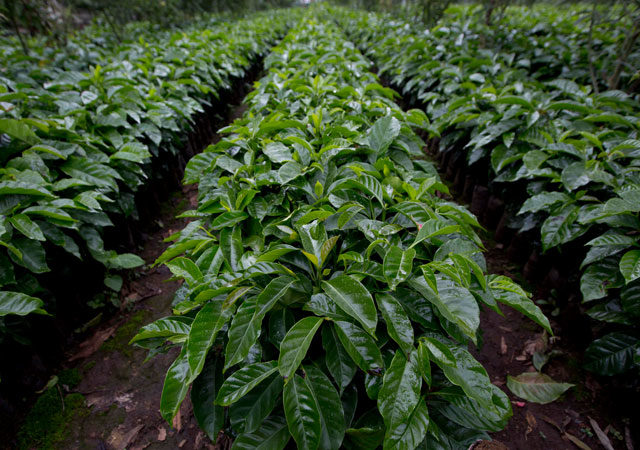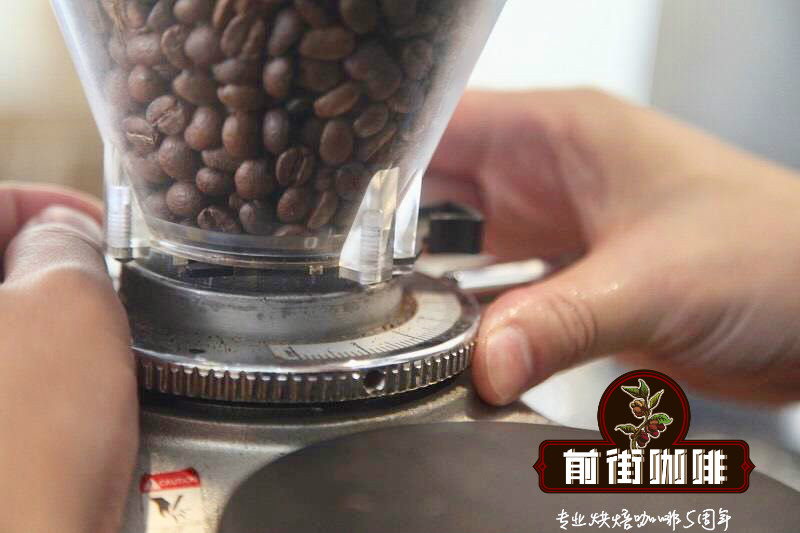What is the price of Robusta's coffee beans? where can I find high-quality Robusta coffee beans?
For professional baristas, please follow the coffee workshop (Wechat official account cafe_style)

ESPRESSO formula
The ideal Italian Espresso is very low acidity, high alcohol thickness, and has a rich, velvety, thick reddish brown Crema with coffee aroma and flavor. Crema is the only important indicator of complete Espresso. Basically, it must master the strong flavor of coffee. The vapor produced during the extraction of Espresso is contained in fine oil foams. When drinking Espresso, these foams explosively release volatile aroma molecules from the mouth to the olfactory receptors in the nasal cavity. These foams also attach to the taste buds, creating a long finish that can last up to an hour. Some people like to make SOE (Single-Origin Espresso) from a single cup of coffee, which may be very simple, but I believe the result needs to be compromised. Because no single coffee provides all the physical and flavor characteristics in the right balance, high-quality Espresso must combine two or more cups of coffee.
To put it simply, I think the characteristics of Espresso can be described in two broad and different directions. Physical characteristics: such as color, richness, Crema; flavor characteristics: such as aroma, taste and aftertaste. The physical trait consists of one group of coffee, while the flavor trait comes from another group of coffee. Although these two qualities are not really separable, I have to make a choice so that coffee, which provides a thick texture for Espresso, has less aroma and taste, and vice versa. Where practicable, the variants of the two groups of traits can be adjusted independently.
Sun-cured coffee tends to have more Crema than washed coffee. If you can find a low-acidity, high-alcohol suntan coffee, it will be a good base for Espresso. Asian coffee, especially from India and Indonesia, as well as Brazilian coffee, offers a low acidity option. After selecting the base beans, we need to evaluate whether this formula is suitable for adding high-quality Robusta. High-quality Robusta is difficult to obtain and expensive, usually more expensive than many Arabica. But Espresso can use clean, mild boutique Robusta. Different from the general grade, the higher unit price Robusta can produce a smoother, milder, softer taste without a rubber finish. In addition, it increases the amount of caffeine in Espresso, an added benefit that many people pursue. The content of Robusta in Espresso beans varies depending on the aging degree, grade, and baking degree of beans. But more importantly, other coffee recipes. Considering that most of the Espresso drinks sold in North America are milk drinks, high-quality Robusta is an effective way to help enhance coffee acceptance. By blending milk, Robusta can help Arabica enhance its flavor.
Perhaps the most significant impact of high-quality Robusta is that it can increase the thickness and persistence of Crema, but it will affect the most important moderation trait of high-quality Espresso. He also added a unique flavor to the taste spectrum, a typical European Espresso flavor, which I believe Arabica is difficult to perform alone.
To add flavor ingredients to the recipe, choose one or two coffees that you really like its aroma and taste. I call them focus Coffee. These coffees can be medium or low alcohol thickness, or even a little sour. Start with one kind of coffee and then add a second coffee flavor if necessary.
Next, you must balance the recipe. All the features must be integrated, and no one in particular overshadows the others. It must be smooth, gentle, thick, free of uncomfortable bitterness, and can not feel sour. Crema should be rich, smooth, velvet-like, and not easy to dissipate, pay special attention to the tail rhyme, the aroma must be very pleasant, so when the oil foam burst, the steam will fill the receptor of the entire nasal cavity, creating a pleasant experience.
Mix first and then bake or bake before mixing
Whether it is premixed raw beans or roasted individually and then mixed, it must depend on the characteristics of the coffee in the formula. Both methods are acceptable. Mixing after baking provides different degrees of baking for each bean so that each ingredient shows the best effect. He also offers non-bakeries the opportunity to create their own exclusive recipes. The most obvious disadvantage of this method is that if the baking plant cares about freshness, it will need to be baked many times and cause wear and tear.
When the roasting properties of the coffee in the formula are compatible, premixing before baking will be feasible. However, when the mesh size, density, water content, thermal conductivity and baking development curve of beans are different, premixed baking will be very difficult and impossible in most cases.
My experience of playing Malaba in India is enlightening. At first, I bake each coffee individually and then mix it. I put great emphasis on freshness. I took order baking and didn't leave baked beans with beans every day. Premixed baking seems attractive because it minimizes baking loss. But the initial attempt to bake such premixed beans had disastrous results. Monsoon Malaba AA is made up of large beans with low density and high moisture, with a moisture content of about 14.5%. On the other hand, Robutsa in this formula is small, high-density, with a water content of about 10.5%. From a baking point of view, these beans should be no different.
But at all stages of baking, some beans remain green, while others are significantly overbaked. Later, it took me three years to adjust the premixed beans to be baked at any time. In the process of this adjustment, I learned a lot about the characteristics of raw beans, and now I know more about every move of roasting these coffees than before.
Translation Note:
The use of Robusta in Espresso formulations has always been a controversial issue in the industry. Traditional Italian coffee must add Robusta to increase the thickness and durability of Crema, fat and viscosity will also be greatly improved. At the same time, it can also reduce the acid value, making the coffee smoother and more chocolate with milk. I don't think there's anything wrong with it. Green vegetables and radishes have their own preferences, and who says using Robusta is not exquisite? In the ten years since the publication of this article, coffee production technology has become more sophisticated, producers have made a single Arabica coffee with more flavor and a good Body, and it is becoming more and more popular to use SOE to express Espresso. The formula made with pure Arabica can also produce a well-balanced taste. But the author is right, first pick the base, and then add an attractive focus, like cooking with seasoning, stack the flavor, so that it is not difficult to make a good Italian recipe. To share my own recipe BadAss Blend, I use Ethiopian sun dumeso as a base, wash Colombia and honey Costa Rica by 30% each to increase the sweet and sour feeling. The aim is to create a clear flavor with floral and berry aromas and a sweet tail.
It is really necessary to study beans after mixing and baking, according to the variety, treatment, density, moisture and particle size as the reference basis, after repeatedly adjusting the proportion, first avoid the risk of burning some ingredients, and then slowly adjust the flavor by baking degree. Based on the careful analysis of the information provided by the raw bean merchants with the current equipment, it is believed that we can pull out the premixed beans that can be baked immediately without spending three years as the author did on indigenous steelmaking.
Important Notice :
前街咖啡 FrontStreet Coffee has moved to new addredd:
FrontStreet Coffee Address: 315,Donghua East Road,GuangZhou
Tel:020 38364473
- Prev

How to mix high-quality coffee beans with different roasting degrees in a single producing area
Communication of professional baristas Please follow the coffee workshop (official Wechat account cafe_style) to roast each coffee with different roasting degrees, test the flavor of each roasted sample separately, and carefully understand the cup-side flavor characteristics of each bean, which is a prerequisite for bean blending. Coffee should be tasted from when it is hot until it cools completely. The vivid memory of these flavor features is the key
- Next

The two main purposes of Italian blending of coffee beans introduce how to adjust the flavor of blended coffee
Professional baristas please pay attention to the coffee workshop (Wechat official account cafe_style) the ideal Italian Espresso formula is very low acidity, high alcohol thickness, and has a rich, velvety, thick reddish brown Crema containing the aroma and flavor of coffee. Crema is the only important indicator of complete Espresso. Basically, it must master coffee strength.
Related
- Detailed explanation of Jadeite planting Land in Panamanian Jadeite Manor introduction to the grading system of Jadeite competitive bidding, Red bid, Green bid and Rose Summer
- Story of Coffee planting in Brenka region of Costa Rica Stonehenge Manor anaerobic heavy honey treatment of flavor mouth
- What's on the barrel of Blue Mountain Coffee beans?
- Can American coffee also pull flowers? How to use hot American style to pull out a good-looking pattern?
- Can you make a cold extract with coffee beans? What is the right proportion for cold-extracted coffee formula?
- Indonesian PWN Gold Mandrine Coffee Origin Features Flavor How to Chong? Mandolin coffee is American.
- A brief introduction to the flavor characteristics of Brazilian yellow bourbon coffee beans
- What is the effect of different water quality on the flavor of cold-extracted coffee? What kind of water is best for brewing coffee?
- Why do you think of Rose Summer whenever you mention Panamanian coffee?
- Introduction to the characteristics of authentic blue mountain coffee bean producing areas? What is the CIB Coffee Authority in Jamaica?

